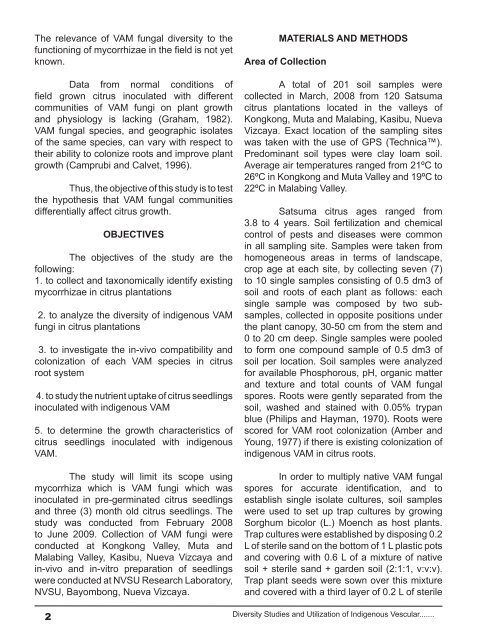download the full article here - EISRJC
download the full article here - EISRJC
download the full article here - EISRJC
You also want an ePaper? Increase the reach of your titles
YUMPU automatically turns print PDFs into web optimized ePapers that Google loves.
The relevance of VAM fungal diversity to <strong>the</strong><br />
functioning of mycorrhizae in <strong>the</strong> field is not yet<br />
known.<br />
Data from normal conditions of<br />
field grown citrus inoculated with different<br />
communities of VAM fungi on plant growth<br />
and physiology is lacking (Graham, 1982).<br />
VAM fungal species, and geographic isolates<br />
of <strong>the</strong> same species, can vary with respect to<br />
<strong>the</strong>ir ability to colonize roots and improve plant<br />
growth (Camprubi and Calvet, 1996).<br />
Thus, <strong>the</strong> objective of this study is to test<br />
<strong>the</strong> hypo<strong>the</strong>sis that VAM fungal communities<br />
differentially affect citrus growth.<br />
OBJECTIVES<br />
The objectives of <strong>the</strong> study are <strong>the</strong><br />
following:<br />
1. to collect and taxonomically identify existing<br />
mycorrhizae in citrus plantations<br />
2. to analyze <strong>the</strong> diversity of indigenous VAM<br />
fungi in citrus plantations<br />
3. to investigate <strong>the</strong> in-vivo compatibility and<br />
colonization of each VAM species in citrus<br />
root system<br />
4. to study <strong>the</strong> nutrient uptake of citrus seedlings<br />
inoculated with indigenous VAM<br />
5. to determine <strong>the</strong> growth characteristics of<br />
citrus seedlings inoculated with indigenous<br />
VAM.<br />
The study will limit its scope using<br />
mycorrhiza which is VAM fungi which was<br />
inoculated in pre-germinated citrus seedlings<br />
and three (3) month old citrus seedlings. The<br />
study was conducted from February 2008<br />
to June 2009. Collection of VAM fungi were<br />
conducted at Kongkong Valley, Muta and<br />
Malabing Valley, Kasibu, Nueva Vizcaya and<br />
in-vivo and in-vitro preparation of seedlings<br />
were conducted at NVSU Research Laboratory,<br />
NVSU, Bayombong, Nueva Vizcaya.<br />
MATERIALS AND METHODS<br />
Area of Collection<br />
A total of 201 soil samples were<br />
collected in March, 2008 from 120 Satsuma<br />
citrus plantations located in <strong>the</strong> valleys of<br />
Kongkong, Muta and Malabing, Kasibu, Nueva<br />
Vizcaya. Exact location of <strong>the</strong> sampling sites<br />
was taken with <strong>the</strong> use of GPS (Technica).<br />
Predominant soil types were clay loam soil.<br />
Average air temperatures ranged from 21ºC to<br />
26ºC in Kongkong and Muta Valley and 19ºC to<br />
22ºC in Malabing Valley.<br />
Satsuma citrus ages ranged from<br />
3.8 to 4 years. Soil fertilization and chemical<br />
control of pests and diseases were common<br />
in all sampling site. Samples were taken from<br />
homogeneous areas in terms of landscape,<br />
crop age at each site, by collecting seven (7)<br />
to 10 single samples consisting of 0.5 dm3 of<br />
soil and roots of each plant as follows: each<br />
single sample was composed by two subsamples,<br />
collected in opposite positions under<br />
<strong>the</strong> plant canopy, 30-50 cm from <strong>the</strong> stem and<br />
0 to 20 cm deep. Single samples were pooled<br />
to form one compound sample of 0.5 dm3 of<br />
soil per location. Soil samples were analyzed<br />
for available Phosphorous, pH, organic matter<br />
and texture and total counts of VAM fungal<br />
spores. Roots were gently separated from <strong>the</strong><br />
soil, washed and stained with 0.05% trypan<br />
blue (Philips and Hayman, 1970). Roots were<br />
scored for VAM root colonization (Amber and<br />
Young, 1977) if <strong>the</strong>re is existing colonization of<br />
indigenous VAM in citrus roots.<br />
In order to multiply native VAM fungal<br />
spores for accurate identification, and to<br />
establish single isolate cultures, soil samples<br />
were used to set up trap cultures by growing<br />
Sorghum bicolor (L.) Moench as host plants.<br />
Trap cultures were established by disposing 0.2<br />
L of sterile sand on <strong>the</strong> bottom of 1 L plastic pots<br />
and covering with 0.6 L of a mixture of native<br />
soil + sterile sand + garden soil (2:1:1, v:v:v).<br />
Trap plant seeds were sown over this mixture<br />
and covered with a third layer of 0.2 L of sterile<br />
2 Diversity Studies and Utilization of Indigenous Vescular.......

















